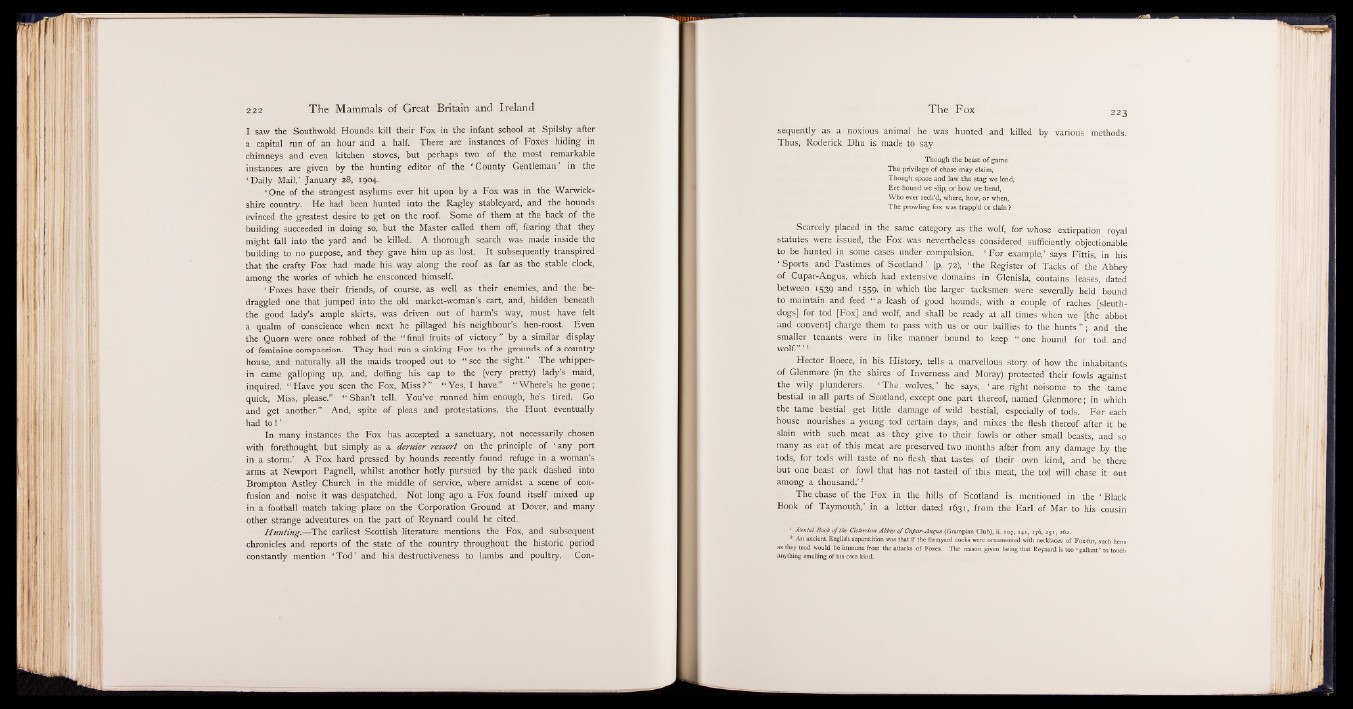
I saw the Southwold Hounds kill their Fox in the infant school at Spilsby after
a capital run of an hour and a half. There are instances of Foxes hiding in
chimneys and even kitchen stoves, but perhaps two of the most remarkable
instances are given by the hunting editor of the ‘ County Gentleman ’ in the
‘ Daily Mail/ January 28, 1904.
‘ One of the strangest asylums ever hit upon by a Fox was in the Warwickshire
country. He had been hunted into the Ragley stableyard, and the hounds
evinced the greatest desire to get on the roof. Some of them at the back of the
building succeeded in doing so, but the Master called them off, fearing that they
might fall into the yard and be killed. A thorough search was made inside the
building to no purpose, and they gave him up as lost. It subsequently transpired
that the crafty Fox had made his way along the roof as far as the stable clock,
among the works of which he ensconced himself.
‘ Foxes have their friends, of course, as well as their enemies, and the bedraggled
one that jumped into the old market-woman's cart, and, hidden beneath
the good lady’s ample skirts, was driven out of harm’s way, must have felt
a qualm of conscience when next he pillaged his neighbour’s hen-roost. Even
the Quorn were once robbed of the “ final fruits of victory” by a similar display
of feminine compassion. They had run a sinking Fox to the grounds of a country
house, and naturally all the maids trooped out to “ see the sight.” The whipper-
in came galloping up, and, doffing his cap to the (very pretty) lady’s maid,
inquired, “ Have you seen the Fox, Miss^” “ Yes, I have.” “ Where’s he gone;
quick, Miss, please.” “ Shan’t tell. You’ve runned him enough, he’s tired. Go
and get another.” And, spite of pleas and protestations, the Hunt eventually
had to !
In many instances the Fox has accepted a sanctuary, not necessarily chosen
with forethought, but simply as a dernier ressort on the principle of ‘ any port
in a storm.’ A Fox hard pressed by hounds recently found refuge in a woman’s
arms at Newport Pagnell, whilst another hotly pursued by the pack dashed into
Brampton Astley Church in the middle of service, where amidst a scene of confusion
and noise it was despatched. Not long ago a Fox found itself mixed up
in a football match taking place on the Corporation Ground at Dover, and many
other strange adventures on the part of Reynard could be cited.
Hunting.—The earliest Scottish literature mentions the Fox, and subsequent
chronicles and reports of the state of the country throughout the historic period
constantly mention ‘ Tod ’ and his destructiveness to lambs and poultry. Consequently
as a noxious animal he was hunted and killed by various methods.
Thus, Roderick Dhu is made to say
Though the beast o f game
The privilege of chase may claim,
Though space and law the stag we lend,
Ere hound we slip, or bow we bend,
Who ever reck’d, where, how, or when,
The prowling fox was trapp’d or slain ?
Scarcely placed in the same category as the wolf, for whose extirpation royal
statutes were issued, the Fox was nevertheless: considered sufficiently, objectionable
to be hunted in some cases under compulsion, ‘ For example,’ says Fittis, in his
• Sports and Pastimes of Scotland ’ (p. 72® the Register of Tacks of the Abbey
° f Cupar-Angus, which had extensive domains in Glenisla, contains leases, dated
between 1539 and 1559,. in .which the larger tacksmen were severally held bound
to maintain and feed “ a leash of good hounds, with a couple of raches [sleuth-
lags] for tod [Foxf and wolf, and shall be ready at all times when we [the abbot
and convent] charge them to pass with us or our baillies to the hunts” 1; and the
smaller tenants were inffite manner bound to keep “ one hound for tod and
wolf.’” 1
Hector Boece, in his History, tells a marvellous story of how the inhabitants
• f f Glenmore (in the shir|s.i|||; Inverness and Moray) protected their fowls against
the wily plunderers. ' The wolves, ’ he says, ‘ are right noisome to the tame
bestial in all parts of Scotland, except one part thereof, named Glenmore; in which
the tame bestial get little damage of wild bestial, especially of tods. For each
house nourishes a young tod certain days, and mixes the flesh thereof after it be
slain with such meat as they g i |p to their fowls or other small beasts, and sb;
many as eat of this meat are preserved two months after from any damage by the
tods, for tods will taste of no flesh that tastes of their own kind, and be there
but one beast or fowl that has not tasted of this meat, the tod willi chase it out
among a thousand.’ 3
The chase of the Fox in the h i l^ of Scotland is mentioned in the ‘ Black
Book of Taymouth,’ in a letter dated 1631, from the Earl of Mar to his cousin
1 Rental Booh o f the Cistercian Abbey o f Cupar-Angus (Grampian Club), ii. 107,141, 176, 25,1, 26a.
* An ancient English superstition was that if the farmyard cocks were ornamented with necklaces of Fox-fur. such hens
as they trod would be immune from the attacks of Foxes. The reason given being that Reynard is too * gallant' to touch
anything smelling of his own kind.